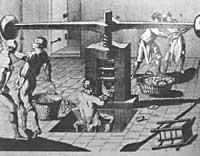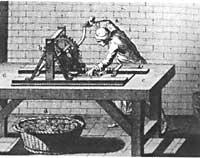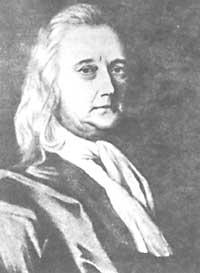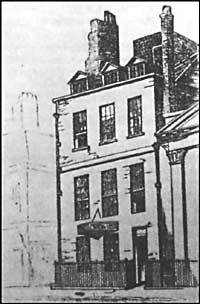Philosophical foundations of Newtonian science
A. Newton methodology


Newton considered himself a natural philosopher. XVII. In the 20th century, the word natural philosopher referred to the phenomena of nature, that is, the movements and paths of bodies, the rays of light, etc. The natural philosopher, therefore, was a present physicist. And Philosophiae Naturalis, who appears in the title of his peak work, is only our present Physics. XVII. In the twentieth century there were two thoughts whose synthesis will be the genesis of Physics. On the one hand, physical-mathematical thinkability (which comes from the hand of Descartes, Cavalieri, Fermat, Pascal, Barrow or Huygens) and on the other, less mathematical or deductive, but more empirical and experimental (by Gassendi, Boyle or Hooke). The new science, Physics, is the result of Newton's synthesis between these two corpses.
Hypotheses and phenomena
The starting point of Newtonian science is the analysis of the quantification of forces. Forces are not visible, but can be expressed by numbers. Consequently, the explanation of the phenomena that occur in nature can be carried out following a system of composition (synthesis) of forces that corresponds to the physical-mathematical (mechanical) principles that must be established. The first objective is the determination of mechanical principles.
For this, we can only use reason (i.e., mathematical calculation) and experimentation, avoiding explanations based on mere hypothesis (see Opticks beginning (1704)). Here is an explanation that is not empirically verified. In Newtonian language, therefore, hypotheses are prefixed causal acceptances; they are not subjected to experimental verification(1). Hypotheses can be physical or mechanical.
Newton uses the word physical hypothesis in a specific sense: to designate the force, substance or structure of Nature that appears as a causal explanation without verification. When the physical hypothesis admits the same type of quantitative analysis that can be used in the study of measurable bodies and movements for the properties it states, it becomes a mechanical hypothesis. Therefore, when Newton impeded the physical hypotheses considered unfounded premises, he impeded the analysis of immense properties.
However, it is evident that Newton also materialized hypotheses in the modern meaning of the word, that is, as a thought that must then endure experimental verification. Newton in his old age called them queries or questions. While the queries are confirmed or prevented, the mechanical hypotheses that do not lead to experimental contrast (remaining as hypotheses, without becoming a query a) are unconfirmed explanations, that is, fictions by causes.
But we must not think that Newton never made wrong hypotheses. He also entered into significant contradictions with his Scholium Generale de Principia, hypotheses non fingo. This type of hypothesis is formulated in different places (2): for example, the perception of stagnation in the center of the universe, or the nature of light (formed by body particles that are transmitted in the ether medium). However, in these cases, Newton, for example, when he speaks of the Puzzana hypothesis, clearly distinguishes between the Aierna understanding and its theory with respect to it, which, of course, he had obtained by experimental means. This is the point that will always appear to us accurately: the strict separation between what can be demonstrated and what cannot be.
Only what can be demonstrated experimentally, which is derived from phenomena, must be accepted. Phenomena are the starting point of their science ( argue from Phenomena without feigning Hypotheses). Of course, phenomena are experimental or observable data with direct implications, but also laws based solely on the finite number of observations in Newton. That is why it gives the explicit name to Kepler's laws as a phenomenon. In his opinion, rather than as law, we could consider it an empirical regularity that is inferred from a finite number of observable data.
Analysis/Synthesis Method
Science must start from phenomena (observable data and empirical regularities) and act according to the method of analysis and synthesis (or Composition). The first part of the method, as mentioned, must be based on experiments and observations to obtain conclusions that have the character of laws or principles, using only the induction pathway based on analog inference (III. When talking about the rule, we will see more specifically).
Whatever does not come from experimentation or truths obtained through mathematical reasoning, will not be admitted as an objection to these principles. Newton, as indicated in the query 3 of his Opticks, with this procedure of analysis we can move from the movements to the forces that provoke them, and in general, from the conclusions to their causes and from the particular causes to other more general ones, until the reasoning ends in the more general cause.
The phase corresponding to the synthesis consists in recognizing the causes encountered and explaining the phenomena that can derive from these principles, demonstrating all the steps taken. In this whole process the hypotheses (in the sense of the dear question) have a great heuristic value: they give beginning to the avenues of research to contrast. However, these hypotheses should not be explained in the latest systematization, since it can only resort to the double analysis/synthesis procedure by analog induction and mathematical demonstration.
How the scientist should be
XVIII. Since the second half of the 20th century, the scientific community accepts almost unanimously, not only the method of analysis/analysis, but Newton approves the III. Also the logical and epistemological conceptions that briefly exposes in the section of Regulae Philosophandi (rules of philosophy) of the beginning of the volume:
Rule I: We should only accept as causes of natural things those who are able to explain their appearance.
II. rule: To the same natural effects, we must adhere to the same causes.
III. rule: All bodily qualities within the limits of our experiments must be regarded as universal properties of every body.
IV. rule: In experimental philosophy, despite making any contrary hypothesis correct, we must seek proposals that from phenomena can be inferred in a real or almost real way through general induction, and this will be done until other new phenomena occur that can be performed by more precise propositions or linked to exceptions.
The first two rules basically explain the same idea: the basis of science, as Galilei has said, must be as simple as possible.
III. In the rule, the empiricism of Newton's experimental philosophy (the new physical science) is opposed to Descartes' apriorism, since, as explained in the corresponding annex, we do not perceive that all bodies are inpenetrable in fusion, but for reason, but for sensation. We discovered that the bodies we use are inpenetrable in battle and hence inaccessibility is a general property of all bodies.
Thus, we must abandon the fictions of hypotheses and rely on experiments, which allow us to speak of analogy of nature based on simplicity. This analogy allows us to make inductive inferences that allow us to extract from finite experiments general qualities of every body. Based on this lockian root empiricism, and against the innatism of Descartes (who managed to express a single general characteristic of corpuscle materials: its extension), Newton, in addition to the inpenetrability in the song, explained other qualities of bodies, such as hardness, mobility, mobility...
IV. It aims to delve into what was stated by rule III, which in its day (and today) was difficult to approve. For this, IV. the rule wants to give the maximum order of correct scientific behavior: we must associate them with facts and if these do not coincide with abstract and philosophical hypotheses, with the heart those hypotheses to grains!
B. Epistemological exercises
I.B. To what Cohen has called science a newtondar way, Regulae Philosophandi begins: from phenomena, the attainment of principles, and then again demonstrate other phenomena of higher rank.

So far we have analyzed hypotheses, queries or hypotheses in the current sense, phenomena, method and Newtonian rules. The similarity of Kepler's laws (which Newton, as already mentioned, considered an empirical regularity) was the first level of inductive abstraction. However, principles place us in the background of abstraction higher than the previous one.
Mechanical principles
The principles of physics are laws in the strict sense. They express a ratio or proportion in their statement or, using the updated expression, a mathematical formula or a functional relationship. Mechanical principles indicate how scientists have understood the phenomenon or a set of phenomena, and in this understanding mathematics is the most accurate. Newton realized all this. The formulation of its mechanical principles requires measurements, for which measurement standards must be established (that are nothing more than a ratio between data in quantity).
Therefore, the detection of a new measurement rule can be considered the search for a new physical law. The definitions of mass and momentum (amount of movement) that initiate the presentation of axiomatized mechanics in the Principles clearly indicate that these concepts include in their meaning the rules of measurement. Based on these concepts, measurement standards are also incorporated into mechanical principles. Both definitions are formulated as:
Definition I: The measurement of matter will be expressed according to its density and volume.
II. definition: The measure of the amount of movement (momentum) will be expressed according to the amount of speed and materi.
In turn, the meaning of force (as we shall see later, even if we do not want to extend hypotheses about the nature of force) is the result of the product of mass by acceleration. This measure is obtained: II. according to the definition, the amount of movement = m.v; according to the second Newtonian law of movement (3), the variation of the amount of movement (i.e., the variation of momentum) is proportional to the force it has produced. It is therefore the measure of force that has produced a change in the amount of movement. The measure of force is established as the product of mass by acceleration (although its current formulation corresponds to Euler and not to Newton).
Active ingredients
The phenomena of nature must be explained according to the mechanical principles expressed mathematically, taking advantage of the process we have seen before: from the consequences to the causes and from them to more general ones until the first cause is obtained. But Newton recognizes that this cause is not mechanical. (28). Querya, Opticks).
He thus condemns mechanicism (that is, the explanation of natural phenomena only according to mechanical laws) and claims to believe in a divine author, since, elsewhere, the movements of the planets cannot be a consequence of a natural cause, but of an Intelligent Agent.
Therefore, a hierarchy is created in the causes of phenomena: God is an original and effective principle, while mechanical principles are passive principles. For example, if only the latter were, according to the first Newtonian law of movement (the principle of inertia) there would be no movement in the world. Other principles should affect the bodies so that they move (and, once initiated, remain). There must be active, effective principles. God is, of course, the first of them, but there are others such as gravitation and forces involved in chemical and alchemical processes.
These effective principles are not excluded from the analysis of experimental science. Hence Newton's (4) interest in alchemy and on the other theological side, due to the neoplatonism of the time. In fact, alchemy studies effective spirits in materials, and natural philosophy itself (Physics), starting from the appearance of phenomena, must help solve the theological problems that affect human, human, intelligent and omnipresent existence.
Constructive elements of the world
For Newton, the greatest importance of his physical science lies in the study of approximation to the first cause. However, by not getting the generality of his project, he limited himself to global research.

If for Descartes the world consists of two elements (extension and movement), for Newton it consists of matter (infinite number of particles), motion (result of the motor forces appearing according to mechanical laws) and space (understood as absolute, in which particles and bodies move).
To the three elements that build the world we must add the fourth: attraction (5). Although it is an element that harmonizes the world, it is not part of it. It can be of divine origin or of a material author. In any case, everyone can maintain their opinion, since for scientific explanation there are no differences between the material and immaterial cause. As he writes in the Scholium Generale de Principia, the most important thing is that for us it is enough to know that gravity really exists and that it acts according to the laws that we have exposed and that it also serves to understand all the movements of the celestial bodies and our sea. The widespread use of gravitational law therefore restores the physical unity of the Newtonian Universe and, at the same time, endows its intellectual integrity.
It is no wonder that the concept of general gravitation is initially debatable. In fact, he refused to attract Newton's new vision. Gravity appeared as a trend to the center of the world of heavy bodies. Newton shows that his concept is new, which explains the movements of Nature, although he does not know what its ontological cause is. However, the most important scientists of the time, such as Leibniz and Huygens, did not accept the concept, since this notion of remote influence had a tone of retrograde obscurantism. However, and as we shall see in the article on Newton's esoteric activity, this distance movement reflects a magical view of the reality of alchemias and neoplatonists.
This seemingly dark principle (and that in the sense of Huygens and Leibniz could not be admitted as an explanation of anything, since he also had to have clarified before) and the problems that derive from it will be those that will require Newton a broad reflection. The conclusion is the book Principia. With this a new science is initiated based on a dynamic conception of physical causality and linked to theistic metaphysics, which should not be understood as a complement to Newtonian science, but which in its system supposes more than something empty.
Today, from Newton's contributions we have a purely scientific aspect, perhaps the least important for him.
BIBLIOGRAPHY
- BECHLER, Z. (col. ), Contemporary Newtonian Research,
Dordrecht, Reidel, 1982. - COHEN, I.B., The Newtonian Revolution, Cambridge, Cambridge
University Press, 1980. - KOYRE, A., Etudes newtoniennes, Paris, Gallimard, 1968.
- Newton, I., Optica, Madrid, Alfaguara, 1977.
- Newton, I., Mathematical Principles of Natural Philosophy,
Madrid, Ed. National, 1982. - TRUESDELL, C.A., Ensayos de historia de la Mecánica, Madrid,
Tecnos, 1975.
OBSERVATIONS
- Newton's behavior toward hypotheses has been (and still is) the cause of one of the most serious polemics in History and the Philosophy of Science. Here we cannot account for this controversy, but it is usually assumed that Newton was increasingly considered worse. From being synonymous with general law at first ( De motu Corporum, 1684) they became the anemized Scholium Generale, which are annexed to the publication 1713 of Principia, and which here appear to us as arbitrariness and synonyms of fiction. Undoubtedly, the controversy with Descartes and Leibniz had much to do with this change.
- The most numerous and harsh anti-hypothesis anathemas are found in his book Opticks. 31 of this book. Query an wrote: For Hypotheses are not to be regarded in experimental Philosophy, and in 28 we read: the main Business of natural Philosophy is to argue form Phenomena without feigning Hypotheses.
- This law remains highly debatable. Some consider it a tautological definition of the concept force. Other empirical laws. And the position in favor of one or the other depends on the current philosophy of each one (rationalism, empiricism, etc. ). ). In my opinion, it is a metalegea without empirical content and only serves to clarify how mechanical laws should be used.
- In this same journal we will offer an article to the disciplines related to these aspects.
- Koyrex stressed the convenience of separating attraction and gravitation, although they are usually used as synonyms. Gravity is a sensitive quality directly collected in the natural body. The attraction is to operate remotely between two qualitatively defined bodies. A. Koyré, Etudes newtoniennes, 11-12 pp.
Buletina
Bidali zure helbide elektronikoa eta jaso asteroko buletina zure sarrera-ontzian











